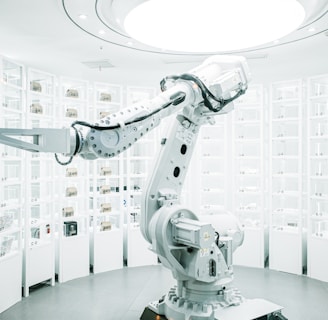How AI Is Transforming Medical Education in Rural America.
AI is revolutionizing medical education in rural America with virtual labs, AI tutors, and global access bridging the gap between rural students and top-tier healthcare training.
11/6/20252 min read


Introduction
Rural America has long struggled with limited access to advanced medical education, distant universities, scarce lab facilities, and understaffed programs. Now, artificial intelligence (AI) is quietly changing that reality. From AI-powered tutors to virtual anatomy labs, technology is giving rural students the same opportunities as their urban counterparts. Here’s how AI is reshaping the future of healthcare education and why this matters more than ever.
1. AI Tutors Bringing Personalized Medical Learning
Imagine having a tutor that’s available 24/7 explaining anatomy, diagnostics, or biochemistry in plain, human terms. That’s the reality of tools like ChatGPT, Google Gemini, and other large-language-model applications. These tools allow students to:
Generate case studies or medical scenarios on demand. American Medical Association+2PMC+2
Quiz themselves on pharmacology or pathology anytime.
Simplify complex topics using visuals or analogies.
For rural universities with limited faculty, AI tutoring is a game-changer it scales mentorship and keeps learning personal.
2. Virtual Labs: Hands-On Experience Without Physical Labs
AI-powered lab simulators such as Labster, FundamentalVR, and BodyMap replicate realistic medical environments online. Students can perform dissections, learn body systems, or analyze patient data all via a laptop or VR headset.
💡 Why it matters: These digital labs save costs, require no extensive physical infrastructure, and often work on modest internet making them especially suitable for rural campuses.
3. Smarter Diagnostics and Virtual Case Studies
AI systems are now generating realistic clinical cases for students to solve complete with symptoms, lab results, and simulated ultrasound or imaging data. Instructors use these tools to assess reasoning and decision-making without needing physical patients. AAMC+1
In rural settings, where access to high-risk or rare cases is rare, these simulated cases bring opportunity to students who might otherwise never see such scenarios during training.
4. Global Access Through AI Translation and Tele-Teaching
Students in small-town America can now attend lectures from top institutions via AI-driven translation and streaming. With tools like DeepL and Whisper, lectures can be subtitled or translated instantly. postgraduateeducation.hms.harvard.edu+1
Result: equal opportunity, no matter the ZIP code.
5. Current Breakthroughs That Raise the Game
New research shows large-language-model (LLM) systems are being integrated into medical curricula institutions now train students to use AI rather than fear it. AAMC+1
AI in rural healthcare settings is showing real promise: edge-computing tools enable diagnostics and telehealth in under-resourced clinics. dtresearch.com+1
AI-driven simulation platforms like “MedSimAI” generate full patient-encounter simulations for students, offering unlimited practice opportunities previously unavailable in rural settings. arXiv+1
AI tools can now predict diseases and patient-outcomes in underserved communities before symptoms appear this has implications for training rural medical students to think proactively. World Economic Forum
These breakthroughs aren’t just “techy” they directly improve educational access, quality of training, and ultimately the healthcare delivered in rural regions.
6. Bridging the Healthcare Gap: Training + Practice
AI isn’t just training students — it’s equipping them to serve their communities once they graduate. Telehealth, AI-enabled diagnostics, and remote mentorship create a cycle of improved patient care and local empowerment. Rural-trained professionals using AI can help close the healthcare gap one county at a time.
Conclusion: The Future of Medicine Starts in Small Places
AI is democratizing medical education — giving rural students the same access, tools, and mentorship as elite urban institutions. The result is a stronger, smarter healthcare system built from the ground up. For educators, rural institutions, and students alike, the message is clear: you no longer need to relocate to get world-class training. The future of medicine might just begin right in your hometown.
Call to Action
If you’re an educator, a student, or a medical training program exploring how AI can reshape rural healthcare education keep following Teacher AI Daily. We share simple, actionable AI tools you can use today to make teaching and learning faster, smarter, and more accessible.